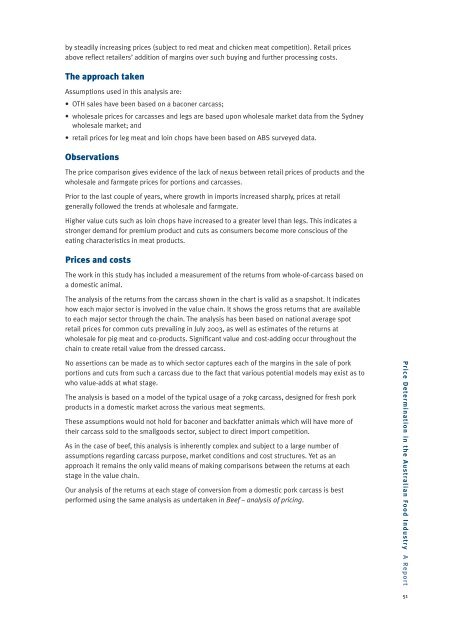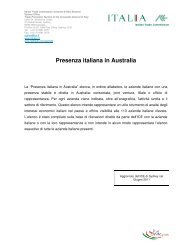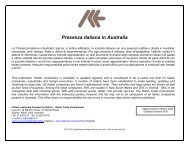Price Determination in the Australian Food Industry A Report
Price Determination in the Australian Food Industry A Report
Price Determination in the Australian Food Industry A Report
Create successful ePaper yourself
Turn your PDF publications into a flip-book with our unique Google optimized e-Paper software.
y steadily <strong>in</strong>creas<strong>in</strong>g prices (subject to red meat and chicken meat competition). Retail prices<br />
above reflect retailers’ addition of marg<strong>in</strong>s over such buy<strong>in</strong>g and fur<strong>the</strong>r process<strong>in</strong>g costs.<br />
The approach taken<br />
Assumptions used <strong>in</strong> this analysis are:<br />
• OTH sales have been based on a baconer carcass;<br />
• wholesale prices for carcasses and legs are based upon wholesale market data from <strong>the</strong> Sydney<br />
wholesale market; and<br />
• retail prices for leg meat and lo<strong>in</strong> chops have been based on ABS surveyed data.<br />
Observations<br />
The price comparison gives evidence of <strong>the</strong> lack of nexus between retail prices of products and <strong>the</strong><br />
wholesale and farmgate prices for portions and carcasses.<br />
Prior to <strong>the</strong> last couple of years, where growth <strong>in</strong> imports <strong>in</strong>creased sharply, prices at retail<br />
generally followed <strong>the</strong> trends at wholesale and farmgate.<br />
Higher value cuts such as lo<strong>in</strong> chops have <strong>in</strong>creased to a greater level than legs. This <strong>in</strong>dicates a<br />
stronger demand for premium product and cuts as consumers become more conscious of <strong>the</strong><br />
eat<strong>in</strong>g characteristics <strong>in</strong> meat products.<br />
<strong>Price</strong>s and costs<br />
The work <strong>in</strong> this study has <strong>in</strong>cluded a measurement of <strong>the</strong> returns from whole-of-carcass based on<br />
a domestic animal.<br />
The analysis of <strong>the</strong> returns from <strong>the</strong> carcass shown <strong>in</strong> <strong>the</strong> chart is valid as a snapshot. It <strong>in</strong>dicates<br />
how each major sector is <strong>in</strong>volved <strong>in</strong> <strong>the</strong> value cha<strong>in</strong>. It shows <strong>the</strong> gross returns that are available<br />
to each major sector through <strong>the</strong> cha<strong>in</strong>. The analysis has been based on national average spot<br />
retail prices for common cuts prevail<strong>in</strong>g <strong>in</strong> July 2003, as well as estimates of <strong>the</strong> returns at<br />
wholesale for pig meat and co-products. Significant value and cost-add<strong>in</strong>g occur throughout <strong>the</strong><br />
cha<strong>in</strong> to create retail value from <strong>the</strong> dressed carcass.<br />
No assertions can be made as to which sector captures each of <strong>the</strong> marg<strong>in</strong>s <strong>in</strong> <strong>the</strong> sale of pork<br />
portions and cuts from such a carcass due to <strong>the</strong> fact that various potential models may exist as to<br />
who value-adds at what stage.<br />
The analysis is based on a model of <strong>the</strong> typical usage of a 70kg carcass, designed for fresh pork<br />
products <strong>in</strong> a domestic market across <strong>the</strong> various meat segments.<br />
These assumptions would not hold for baconer and backfatter animals which will have more of<br />
<strong>the</strong>ir carcass sold to <strong>the</strong> smallgoods sector, subject to direct import competition.<br />
As <strong>in</strong> <strong>the</strong> case of beef, this analysis is <strong>in</strong>herently complex and subject to a large number of<br />
assumptions regard<strong>in</strong>g carcass purpose, market conditions and cost structures. Yet as an<br />
approach it rema<strong>in</strong>s <strong>the</strong> only valid means of mak<strong>in</strong>g comparisons between <strong>the</strong> returns at each<br />
stage <strong>in</strong> <strong>the</strong> value cha<strong>in</strong>.<br />
Our analysis of <strong>the</strong> returns at each stage of conversion from a domestic pork carcass is best<br />
performed us<strong>in</strong>g <strong>the</strong> same analysis as undertaken <strong>in</strong> Beef – analysis of pric<strong>in</strong>g.<br />
<strong>Price</strong> <strong>Determ<strong>in</strong>ation</strong> <strong>in</strong> <strong>the</strong> <strong>Australian</strong> <strong>Food</strong> <strong>Industry</strong> A <strong>Report</strong><br />
51







